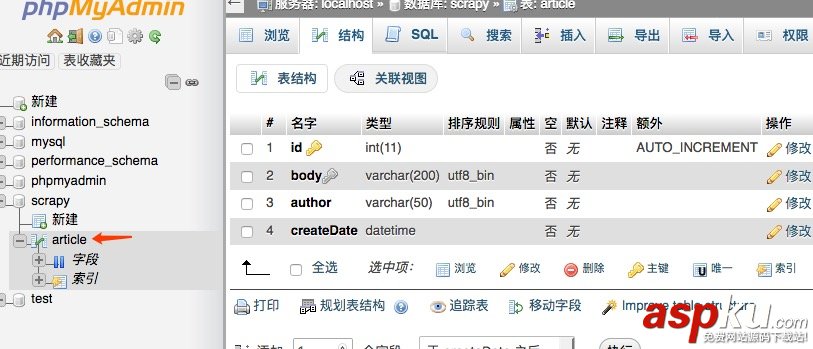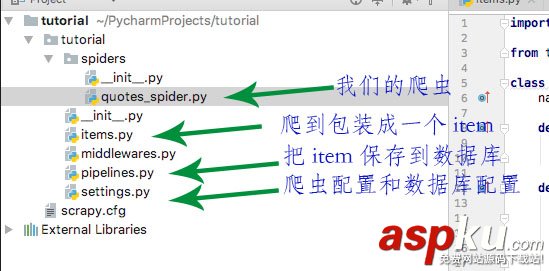前言
本文主要給大家介紹了關(guān)于scrapy爬到的數(shù)據(jù)保存到mysql(防止重復(fù))的相關(guān)內(nèi)容,分享出來供大家參考學(xué)習(xí),下面話不多說了,來一起看看詳細的介紹吧。
1.環(huán)境建立
1.使用xmapp安裝php, mysql ,phpmyadmin
2.安裝python3,pip
3.安裝pymysql
3.(windows 略)我這邊是mac,安裝brew,用brew 安裝scrapy
2.整個流程
1. 創(chuàng)建數(shù)據(jù)庫和數(shù)據(jù)庫表,準備保存
2.寫入爬蟲目標URL,進行網(wǎng)絡(luò)請求
3.對爬返回數(shù)據(jù)進行處理,得到具體數(shù)據(jù)
4.對于具體數(shù)據(jù)保存到數(shù)據(jù)庫中
2.1.創(chuàng)建數(shù)據(jù)庫
首先創(chuàng)建一個數(shù)據(jù)庫叫scrapy,然后創(chuàng)建一個表article,我們這里給body加了唯一索引,防止重復(fù)插入數(shù)據(jù)
---- Database: `scrapy`-- -- -------------------------------------------------------- ---- 表的結(jié)構(gòu) `article`-- CREATE TABLE `article` ( `id` int(11) NOT NULL, `body` varchar(200) CHARACTER SET utf8 COLLATE utf8_bin NOT NULL, `author` varchar(50) CHARACTER SET utf8 COLLATE utf8_bin NOT NULL, `createDate` datetime NOT NULL) ENGINE=InnoDB DEFAULT CHARSET=latin1; ---- Indexes for table `article`--ALTER TABLE `article` ADD PRIMARY KEY (`id`), ADD UNIQUE KEY `uk_body` (`body`);

弄好以后是這樣的。
2.2 先看下整個爬蟲項目的結(jié)構(gòu)

quotes_spider.py是核心,負責(zé)對網(wǎng)絡(luò)請求和對內(nèi)容進行處理,然后對整理好的內(nèi)容拋給pipelines進行具體處理,保存到數(shù)據(jù)庫中,這樣不會影響速度。
其他的看 圖說明
2.2 寫入爬蟲目標URL,進行網(wǎng)絡(luò)請求
import scrapyfrom tutorial.items import TutorialItemclass QuotesSpider(scrapy.Spider): name = "quotes" def start_requests(self): url = 'http://quotes.toscrape.com/tag/humor/' yield scrapy.Request(url) def parse(self, response): item = TutorialItem() for quote in response.css('div.quote'): item['body'] = quote.css('span.text::text').extract_first() item['author'] = quote.css('small.author::text').extract_first() yield item next_page = response.css('li.next a::attr("href")').extract_first() if next_page is not None: yield response.follow(next_page, self.parse)start_requests 就是要寫入具體要爬的URL
parse就是核心的對返回的數(shù)據(jù)進行處理的地方,然后以item的形式拋出,接下來定義好下一個要爬的內(nèi)容
2.3 items
# -*- coding: utf-8 -*-# Define here the models for your scraped items## See documentation in:# https://doc.scrapy.org/en/latest/topics/items.htmlimport scrapyclass TutorialItem(scrapy.Item): body = scrapy.Field() author = scrapy.Field() pass
2.4 pipelines
# -*- coding: utf-8 -*-# Define your item pipelines here## Don't forget to add your pipeline to the ITEM_PIPELINES setting# See: https://doc.scrapy.org/en/latest/topics/item-pipeline.htmlimport pymysqlimport datetimefrom tutorial import settingsimport loggingclass TutorialPipeline(object): def __init__(self): self.connect = pymysql.connect( host = settings.MYSQL_HOST, db = settings.MYSQL_DBNAME, user = settings.MYSQL_USER, passwd = settings.MYSQL_PASSWD, charset = 'utf8', use_unicode = True ) self.cursor = self.connect.cursor(); def process_item(self, item, spider): try: self.cursor.execute( "insert into article (body, author, createDate) value(%s, %s, %s) on duplicate key update author=(author)", (item['body'], item['author'], datetime.datetime.now() )) self.connect.commit() except Exception as error: logging.log(error) return item def close_spider(self, spider): self.connect.close();
2.5 配置
ITEM_PIPELINES = { 'tutorial.pipelines.TutorialPipeline':300}MYSQL_HOST = 'localhost'MYSQL_DBNAME = 'scrapy'MYSQL_USER = 'root'MYSQL_PASSWD = '123456'MYSQL_PORT = 33063.啟動爬蟲
scrapy crawl quotes
總結(jié)
以上就是這篇文章的全部內(nèi)容了,希望本文的內(nèi)容對大家的學(xué)習(xí)或者工作具有一定的參考學(xué)習(xí)價值,如果有疑問大家可以留言交流,謝謝大家對VEVB武林網(wǎng)的支持。
新聞熱點
疑難解答
圖片精選